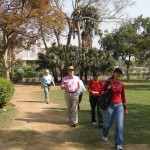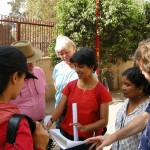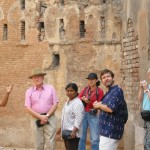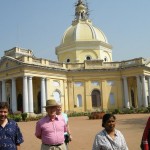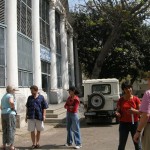Heritage trail: landmarks of 1857, 21 March 2010
- near Nicholson’s cemetery
- old city walls
- inside old city walls
- old St. Stephen’s college
- St. James’ Church
- Dara’s library
- David Ochterlony’s Residency
- Lothian road
Here are some of the pictures of heritage walk exploring Kashmiri gate and its neighbourhood. Most landmarks on this trail relate to the Uprising of 1857. We started from Nicholson’s cemetery. The cemetery is named after John Nicholson, the British commander who died in the fighting during siege of Delhi. Another prominent burial is that of Master Ramachandra of Delhi College fame. An Indian convert to Christianity, he was one of the foremost intellectuals of 19th century. The city walls of Shahjahanabad, the Mughal capital, start almost immediately across the road from the Nicholson’s cemetery. Not much of it remains but some parts are still traceable alongside the Kashmiri gate. Kashmiri gate is one of the remaining gates of the city. The others are: Turkman, Ajmeri and Dilli gates. The breaching of this gate was crucial in turning the tide in favour of the British. The gate still bears the damage done during the fighting. There are large chunks missing in its façade, from impact of canon balls. As we walk towards the car parts market, we could see some traces of colonial architecture; a tiny but elaborately decorated balcony, a pointed arch…
This area was part of the capital city of Delhi and a fair number of British built their houses here, around the Kashmiri gate. Fakhrul Masajid is an 18th century mosque built on the first storey. It is still an active place of worship. A little ahead is the old Hindu college and old St. Stephen’s college buildings. And across the road is St. James’ Church, built by James Skinner, famous for commanding a regiment popularly called Skinner’s Horse. The Church was badly damaged in 1857. The churchyard has the family burial ground of the Skinner family and also William Fraser’s grave. The Residency, home for British ambassadors to Mughal cout is now part of IP University’s campus. The site of the Residency is traditionally believed to have been the library of Prince Dara Shukoh, Shahjahan’s son. There are traces of sandstone work (arches and columns) which indicate Mughal aesthetics. Just outside the campus, on an island on Lothian road stand 2 important 1857 landmarks: the telegraph memorial and remains of a British magazine. Lothian road cemetery the oldest British cemetery in Delhi is at the end of the road.
(posted by Rajesh Ranjan & Kanika Singh, team members, Delhi Heritage Walks)
